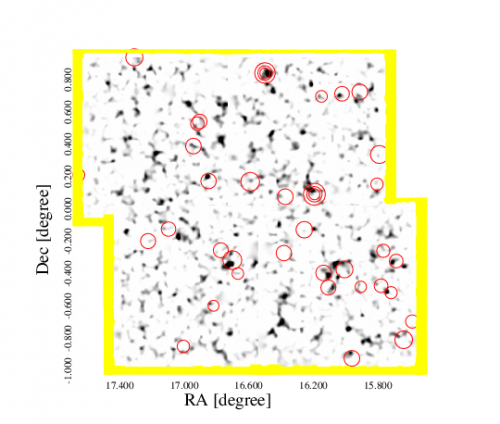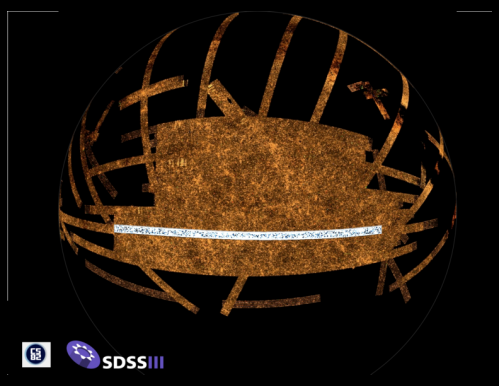Large number of dark matter peaks found using gravitational lensing

A number of studies have shown that dark matter is the principle mass component of the universe making up about 80% of the mass budget. The most direct technique to reveal the dark matter distribution is by using the gravitational lensing technique. Indeed, following Einstein's theory of gravitation, we know that a mass concentration will deform locally the space-time and the observed shapes of distant galaxies seen through the such concentration will be deflected and distorted. By measuring the exact shapes of millions of these distant galaxies we can then map accurately the mass distribution in the universe, and identify the mass peaks tracing mass concentration along their line of sight. Importantly, the number of mass peaks as a function of the mass peak significance encodes important information on the cosmological world model. In particular this distribution is sensitive to the nature of gravitational force at large scales as well as the geometry of the universe. Measuring mass peaks is thus one of the most attractive ways to probe the relative importance and nature of dark matter and dark energy, measure the evolution the universe and predict its fate.
In a new publication of the Monthly Notices of the Royal Astronomical Society, an international team, comprising researchers from Swiss, France, Brazil, Canada, and Germany present the first detailed analysis of the weak lensing peaks. This work is considered as a milestone, given the possible importance of the weak lensing peaks for cosmology. Because mass peaks are identified in two-dimensional dark matter maps directly, they can provide constraints that are free from potential selection effects and biases involved in identifying and measuring the masses of galaxy clusters. In fact a small fraction of the mass peaks are just mass concentration excess along the line of sight, and not genuine massive clusters.
To detect the weak lensing mass peaks, the research team used the Canada-France-Hawaii Telescope Stripe 82 Survey (CS82 in short), still one of the largest weak lensing survey yet. The Survey covers ~170 square degrees of the Stripe 82 of the Sloan Digital Sky Survey (SDSS), an equatorial region of the south galactic cap that has been extensively studied by the SDSS project. With the precise shape measurement for more than four million faint distant galaxies, a dark matter mass map was generated. Huan Yuan Shan, the lead author of this publication explains that: "By studying the mass peaks in the map, we found that the abundance of mass peaks detected in CS82 is consistent with predictions from a LambdaCDM cosmological model. This result confirms that the dark matter distribution from weak lensing measurement can be used as a cosmological probe."

Jean-Paul Kneib, co-author of the publication explains that: "This work opens a new window to constrain cosmology with weak gravitational lensing. We can not only reveal where the dark matter is located using space-time distortion, but also use the distributions of mass peaks to better constrain and understand our universe."
Huan Yuan Shan, adds that: "Because of their large number, the small mass peaks in the dark matter maps contain more resolving power than the most massive peaks to constrain cosmological models." As a cosmological probe, the weak lensing mass peak abundance is very complementary to the other cosmology probes, such as the study of the cosmic microwave background (CMB), the study of distant supernovae, the measure of the baryonic acoustic oscillation and the cosmic shear.
The abundance of mass peaks in the dark matter mass map confirms the theories of structure formation. In the near future, with the upcoming weak lensing surveys (to be conducted with the DES survey, LSST and Euclid), by precisely counting the peaks of dark matter mass maps, we will be able to set constrains on the nature of dark matter and dark energy.
More information: "Weak lensing mass map and peak statistics in Canada-France-Hawaii Telescope Stripe 82 survey," Huan Yuan Shan et al., 2014, MNRAS, Volume 442, Issue 3, pp. 2534-2542 : mnras.oxfordjournals.org/content/442/3/2534 . Arxiv preprint: arxiv.org/abs/1311.1319
Journal information: Monthly Notices of the Royal Astronomical Society , arXiv
Provided by Canada France Hawaii Telescope




















